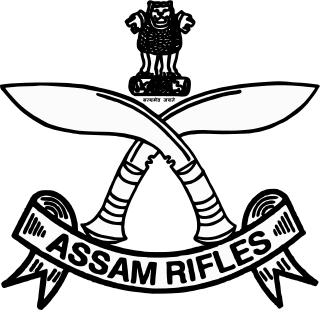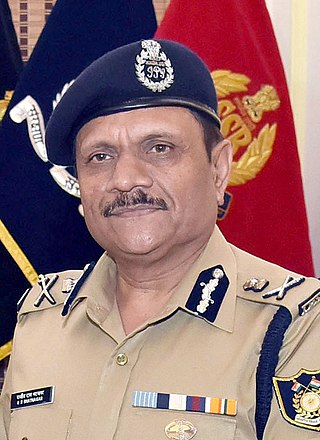
The Border Security Force (BSF) is India's border guarding organisation at its borders with Pakistan and Bangladesh. It is one of the five Central Armed Police Forces (CAPF) of India, and was raised in the wake of the Indo-Pakistani War of 1965 "for ensuring the security of the borders of India and for related matters".

The Central Reserve Police Force (CRPF) is a reserve gendarmerie and internal combat force in India under the authority of the Ministry of Home Affairs (MHA) of the Government of India. It is one among the Central Armed Police Forces. The CRPF's primary role lies in assisting the State/Union Territories in police operations to maintain law and order and counter-insurgency. It is composed of Central Reserve Police Force (Regular) and Central Reserve Police Force (Auxiliary).

The Indo-Tibetan Border Police (ITBP) is a border guarding force of India deployed along its borders with Tibet Autonomous Region. It is one of the five Central Armed Police Forces, established in 1962 in the aftermath of the Sino-Indian War of 1962.

The Assam Rifles (AR) is a central paramilitary force responsible for border security, counter-insurgency, and maintaining law and order in Northeast India. Its primary duty involves guarding the Indo-Myanmar border. The AR is one of the Central Armed Police Forces (CAPF) administered by the Ministry of Home Affairs. The Indian Army maintains its operational control. As a central police force, its recruitment, perks, promotions, and retirement policies are governed by CAPF rules. Approximately 80 percent of the officers are deputed from the Army, while the remaining are drawn from the AR cadre. The AR is commanded by the Director General of the Assam Rifles, appointed by the Ministry of Home Affairs.

Law enforcement in India is imperative to keep justice and order in the nation. Indian law is enforced by a number of agencies. Unlike many federal nations, the constitution of India delegates the maintenance of law and order primarily to the states and territories.

The Central Industrial Security Force (CISF) is a federal police organisation in India under the Ministry of Home Affairs. It is one among the Central Armed Police Forces (CAPF). CISF provides security to over 356 industrial units, government infrastructure projects and facilities and establishments located all over India. These include atomic power plants, space installations, mines, oil fields and refineries, major ports, heavy engineering, steel plants, barrages, fertiliser units, airports and hydroelectric/thermal power plants owned and controlled by Central Public Sector Undertakings (PSUs), and currency note presses.

The Rapid Action Force (RAF), is a specialized rapid reaction wing of the Central Reserve Police Force of India established to deal with riot and crowd control situations.

The Ministry of Home Affairs, or simply the Home Ministry, is a ministry of the Government of India. It is mainly responsible for the maintenance of internal security and domestic policy. It is headed by Minister of Home Affairs.

COBRA is a special operation unit of the Central Reserve Police Force (CRPF) of India proficient in guerrilla tactics and jungle warfare. Originally established to counter the Naxalite movement, CoBRA is deployed to address insurgent groups engaging in asymmetrical warfare. Numbering ten battalions as of 2011, CoBRA is considered to be one of the most experienced and successful law enforcement units in the country.
Devarayapuram Ramasamy Kaarthikeyan is a former Indian Police Service officer from Tamil Nadu, and a former Director of the Central Bureau of Investigation and Director General, National Human Rights Commission.

In India, the Central Armed Police Forces (CAPF) is the collective name of central police organisations under the Ministry of Home Affairs of India. These are technically paramilitary forces formerly known as the Central Para-Military Forces. Since 2011, India adopted the term "central armed police forces" to drop the word "paramilitary". These forces are responsible for internal security and guarding the borders.
The State Armed Police Forces of India are the police units established for dealing with serious law and order situations requiring a higher level of armed expertise than normal. The State Armed Police Forces exist in addition to the ordinary police services of the various states.
The 40 mm Under Barrel Grenade Launcher, is a single shot grenade launcher developed by ARDE and Ordnance Factory Tiruchirappalli for use with the INSAS and AK-47 rifles used by the Indian Army. Stand alone versions of the grenade launcher exist.
An attack on a Central Reserve Police Force camp at Bemina, Srinagar, Jammu and Kashmir, India, occurred on 13 March 2013. It resulted in the death of five CRPF personnel and two attackers. Ten others were also injured include security personnels and civilians.

In the Indian Armed Forces women are allowed to join in combat service support branches and in non combatant roles only and they can only become officers except the Corps of Military Police of the Indian Army where women can become sepoys too. The Indian Air Force had 13.09% (2018) and 8.50% (2014) women; the Indian Navy 6% (2018) and 3% (2014); the Indian Army 3.80% (2018) and 3% (2014). As of 2020, three officers have the rank of lieutenant-general or equivalent, all in the Medical Services. In May 2021, 83 women were inducted as sepoys for the first time in the Indian Army, in the Corps of Military Police.
On 13 March 2018, at least nine Central Reserve Police Force (CRPF) personnel were killed and six others were injured when Maoists blew up a mine-protected vehicle with an IED in Sukma district, Chhattisgarh, India.

The Indian military bands consists of musicians from the Indian Army, Navy and Air Force. Indian military bands regularly participate in international festivals and take part in celebrations dedicated to various national events. These bands are permanent participants in the Delhi Republic Day parade on the Kartavya Path. Today, the Indian Armed Forces have more than 50 military brass bands and 400 pipe bands and corps of drums. A Tri-Services Band refers to a joint Indian Armed Forces military band that performs together as a unit. At the Spasskaya Tower Military Music Festival and Tattoo in Moscow, the band consisted of 7 officers and 55 musicians. The Military Music Wing of the Army Education Corps is the principal educational institution of the armed forces that provides instruction to musicians of all ranks. Instruction is also provided by the Military Music Training Center and the Indian Navy School of Music.

Crowd control in Jammu and Kashmir is a public security practice to prevent and manage violent riots. It is enforced by police forces through laws preventing unlawful assembly, as well as using riot control agents such as tear gas, chili grenades, and pellet guns.

Indian Armed Forces in Jammu and Kashmir encompass the Indian Army, Navy and Air Force, tri-service units such as the Armed Forces Special Operations Division (AFSOD), and paramilitary organisations of the Central Armed Police Forces such as the Border Security Force, the Central Reserve Police Force, the Sashastra Seema Bal and the Indo-Tibetan Border Police. Each three wings of India's military have their special forces deployed in the region including Indian Army's Para SF, the Indian Navy MARCOS and the Indian Air Force's Garud Commando Force. Apart from this, there is the elite police anti-insurgency force in the region, the Special Operations Group, of the Jammu and Kashmir Police.

Rajiv Rai Bhatnagar is a retired Indian Police Service-1983 batch officer of the Uttar Pradesh cadre. Served in different capacities in the various state and central law enforcement organisations, Bhatnagar received the President's Police Medal for Distinguished Service on 15 August 2007. He served as the Director General of the Central Reserve Police Force (CRPF) in his last tenure of service till his retirement on 31 December 2019. He was appointed an advisor to the Lieutenant Governor of Jammu and Kashmir G. C. Murmu by the Government of India in January 2020.
















